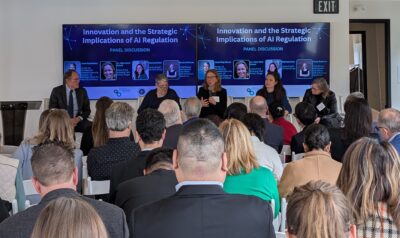BACPoll: One Third of Residents Ponder Leaving Bay Area
Soaring housing costs stemming from a chronic shortage combined with an overwhelmed transportation system and grinding traffic are taking a heavy toll on Bay Area residents, with one third saying they are likely to bolt the region in the next few years, according to results of the 2016 Bay Area Council Poll released today (May 2). Just 40 percent of residents say the region is heading in the right direction, a significant decline from 55 percent last year and 57 percent in 2014.
“This is our canary in a coal mine,” said Jim Wunderman, President and CEO of the Bay Area Council. “Residents are screaming for solutions. Do we expect to see more than 2 million residents up and leave? Of course not. But losing even a fraction of that number and the talent they represent because we failed to deal with our most pressing issues would be very bad. We need to act with urgency, we need to act decisively and we need to act regionally to address the underlying problems of housing and traffic that are causing discontent and aggravation.”
The urge to leave is strongest among residents who have been here the shortest time, those making lower incomes and those paying a larger share of income for housing. Despite the 34 percent of residents who are eyeing an exit, another 54 percent said they’re not going anywhere. And among those looking to leave, just 13 percent felt strongly about it while 31 percent of residents felt strongly about staying put. Still, the message is clear and alarming as concerns mount about a growing economic divide in the Bay Area.
Read the Bay Area Council Poll summary results>>
See Bay Area Council Poll charts and graphs>>
See complete Bay Area Council Poll results>>
“We need to pull every lever we can to remove regional and local obstacles to creating housing, helping working families afford to live here, eliminating the scourge of traffic and sustaining a healthy economy,” Wunderman said. “We’ve got our work cut out for us, but we’ve also got the tools, ingenuity and creativity to do it.”
Housing, Traffic, Cost of Living Top Concerns
High housing costs topped the list of the Bay Area’s most important problems, the poll found, with 22 percent of residents in an open-ended question naming it first ahead of traffic at 17 percent and cost of living at 9 percent. Given a set list of issues, 25 percent of Bay Area residents ranked cost of living, which is often associated with housing costs, as the region’s most serious problem followed by housing at 23 percent and traffic at 13 percent.
Putting an exclamation point on the results, 64 percent of residents identified cost of living among their top three problems for the Bay Area, with 48 percent citing housing in the top three and 39 percent ranking traffic among the region’s top problems. Poverty and income inequality also figured prominently with 27 percent of residents listing it among the region’s top three problems. That represents a significant jump from 2014, when just 8 percent of residents listed poverty and income inequality among the top three problems in the Bay Area.
There are some notable differences among generational groups when it comes to ranking some of the region’s biggest problems. Millennials and Gen Xers harbor the greatest concern about the cost of living, with 33 percent and 31 percent, respectively, citing it as their top worry compared to 14 percent for Baby Boomers and 13 percent for residents over 65. Housing comes in second among Millennials, Gen Xers, and residents over 65, and is the primary concern among Baby Boomers.
Millennials are more concerned than their elders about poverty and income inequality, with 37 percent rating that among the region’s three most important problems. Gen Xers put poverty and income inequality fourth behind cost of living, housing and traffic; Baby Boomers put it fifth behind housing, cost of living, traffic and crime; and residents over 65 put it seventh behind cost of living, traffic, housing, homelessness, crime and other unspecified problems.
Drought Drowned Out as Top Issue
Concerns about housing costs and the region’s high cost of living drowned out worries about the drought. Even with an under performing El Nino, just 4 percent of Bay Area residents ranked California’s historic drought as their leading concern, a precipitous drop from the 28 percent that put it at the top of the region’s most important problems in 2015.
A look at confidence across counties shows that San Francisco residents are the gloomiest, with 52 percent saying things are the wrong track — up from 28 percent just last year — and 33 percent saying things are heading in the right direction. While the mood is a little better to the south, it’s also fallen a lot further. In Santa Clara County, 37 percent of residents say things are on the right track, down from 67 percent in 2014 and 58 percent in 2015.
Discontent across Generations, Incomes
Overall confidence was generally weak among generations. The poll found 42 percent of Millennials think the Bay Area is headed in the right direction, although 21 percent were strangely undecided about how things are going. Residents 65 years and older expressed a similarly tepid level of optimism while Gen Xers were glummer with 38 percent saying the Bay Area is headed in the right direction and 41 percent expressing pessimism.
Perhaps not surprisingly, the region’s most well off feel the greatest sense of optimism. Among residents with household incomes over $125,000, 46 percent say the Bay Area is headed in the right direction. Optimism slumps in lower income brackets, with 42 percent of residents with household incomes between $75,000-$125,000 saying the region is headed in the right direction and just 38 percent making less than $75,000 feeling optimistic.
The 2016 Bay Area Council Poll, which was conducted by Oakland-based public opinion research firm EMC Research from Feb. 12-March 9, surveyed more than 1,000 residents online about a range of issues related to economic growth, housing and transportation, drought, education and workforce. It has a margin of error of 3.1 percentage points.





